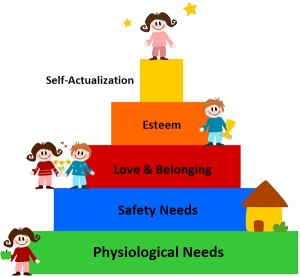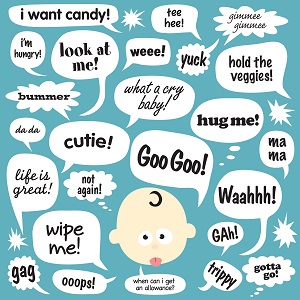16 Apr From Concept to Communication
 Yorrick’s First Concepts
Yorrick’s First Concepts
A conceptually structured model of learning might suggest that Yorrick, or any other human, first acquires concepts, and later, a vehicle for communicating concepts: language. During Yorrick’s early development, his concepts are linked entirely to physical sensations and perceptions: hunger, soreness, the sucking instinct, and the like. One of the first discoveries any infant makes is that crying (another instinctive action) can motivate others to help relieve the sources of negative stimuli. This prompts the infant to experiment on the applicability of the newly learned means of communication. The innate sense that enables babies to make such observations and to initiate such experiments is a sensually based ability to observe cause and effect relationships and a need that is centered on physical stimuli.
Aside: while some researchers focus on a part of the brain as the focus of intelligence, I sense that the instinctive, and even involuntary, capabilities of the entire human body are important parts of a model that will most accurately approximate human communication, and, possibly, other intelligent tasks.
| Understanding Context Cross-Reference |
|---|
| Click on these Links to other posts and glossary/bibliography references |
|
|
|
| Prior Post | Next Post |
| The Myth of Inexpressibility | Learning by Repetition |
| Definitions | References |
| conceptual modeling | Bobrow 1975 |
| learning language | Carpenter 1988 |
| behavior context | About Genie Valiant 1994 |
Hierarchy of Needs
 There is a hierarchy of needs, from survival, to satisfaction, to expression, that will continue to influence Yorrick’s behavior and learning patterns throughout his life. Maslow described such a hierarchy, and its application in the present context is instructive. Needs motivate action and learning. As our needs reach higher plateaus on the hierarchy, we may be motivated to explore new conceptual territory, paving the way for learning.
There is a hierarchy of needs, from survival, to satisfaction, to expression, that will continue to influence Yorrick’s behavior and learning patterns throughout his life. Maslow described such a hierarchy, and its application in the present context is instructive. Needs motivate action and learning. As our needs reach higher plateaus on the hierarchy, we may be motivated to explore new conceptual territory, paving the way for learning.
If we all can achieve some level of fulfillment, what’s left?
Crying to Communicate
Crying is probably our first communicative act. Children quickly learn its role as a communication device. Yorrick, for example, learns that interaction between people is possible through sounds which can be produced by some internal mechanism of which he is vaguely, instinctively aware. By experimenting, he learns to manipulate sounds at will. Caught in the middle of a perceptual flood, Yorrick senses that sounds fill the environment.
Soon, he can distinguish between human and non-human sounds because he correlates images of the speakers with the sounds of their speech. The sound of familiar voices becomes distinguishable, particularly mom’s voice. Vocal dynamics used by more mature speakers in disciplining and in expressing emotions are picked up quickly. A general sense of communication as a system begins to take shape in Yorrick’s mind.
It does not seem like a giant cognitive leap to go from crying to using other sounds (grunts, groans, coos, squeals) to communicate. As the articulating hardware (epiglottis, vocal cords…) matures, Yorrick refines the sounds he makes so they more closely approximate the sounds of mature speech. What would it be like to entirely skip the crying stage? Think of the stories of some of the Jews who went into hiding to try to escape the Nazis: while hiding in attics and secret places, they had to be deathly quiet for hours, sometimes days, at a time. It is said that the babies learned not to cry.
Is it possible that living too long in silence, or other perceptual deficits of this type could profoundly impair a child’s chance to learn to speak? The plight of Genie, the girl who was locked up and deprived of human interaction through her formative years, provides sobering evidence. Surely kids need a steady dose of healthy stimuli.
 First Words
First Words
At the same time he is experiencing a growing awareness of a communication system, Yorrick’s needs begin to expand beyond the digestive and sleep stages to include companionship, distraction, physical activity, and more. This is also the time when Yorrick begins to notice his ability to produce distinctive sounds. As he makes this connection, he begins to note often-repeated audio patterns and attempts to sort them out. If this theory is correct, language learning is a conscious attempt on Yorrick’s part to analyze input and develop a useful skill. With the conscious aid of parents, it can be a joint effort. This conscious effort may begin when Yorrick is several months old, or it may wait until he is a little older.
The first words that Yorrick utters are likely to be simple words related to everyday needs or stimuli: “bottle,” “diaper,” “mama,” “doggy,” or “cheeseburger, hold the pickles and onions.” Some children appear to skip stages entirely as they stay with proven simple communication systems until they can privately master more complex approaches for expressing their thoughts. Early discoveries like getting a response by saying “mama” may be more akin to crying than to speaking. In many cases, “mama” may not be the first word a baby learns, but a second crying device. Nevertheless, there is a point when the child learns about object labels or nouns. Then, “mama” becomes a word.
- Yorrick!
- Mama…
Pursuit of Language
 As Yorrick begins to actively pursue language, his stored input is disjointed and not particularly useful. Gradually, patterns emerge: small, one-to-three syllable patterns at first, then larger ones. This aids Yorrick in segmentation. The patterns are associated with contextual data provided by Yorrick’s eyes, ears and memory of current circumstances. The most frequently repeated words and phrases – about home, family, food, diapers, motion – enter his vocabulary first. Perhaps his conceptual vocabulary consists of many word/concept relations before the articulating mechanism catches up and yields the first fruits of speech.
As Yorrick begins to actively pursue language, his stored input is disjointed and not particularly useful. Gradually, patterns emerge: small, one-to-three syllable patterns at first, then larger ones. This aids Yorrick in segmentation. The patterns are associated with contextual data provided by Yorrick’s eyes, ears and memory of current circumstances. The most frequently repeated words and phrases – about home, family, food, diapers, motion – enter his vocabulary first. Perhaps his conceptual vocabulary consists of many word/concept relations before the articulating mechanism catches up and yields the first fruits of speech.
While Yorrick’s conceptual repertoire may hold thousands of items by this time, most concepts are symbolized as situations and physical sensations in context with no symbolic lexical component. Those concepts first endowed with a symbolic representation, however, happen to be the most important ones in his mind: self, needs, family, and home. Thus, the value of language as a useful symbol system takes hold quickly. For most things, he has yet to move from concept to communication. The immediate rewards of communicating (achieving desired results and praise), however, stimulate more effort.
From “mama” forward, Yorrick and his mind pursue language vigorously.
| Click below to look in each Understanding Context section |
|---|
| Intro | Context | 1 | Brains | 2 | Neurons | 3 | Neural Networks |
| 4 | Perception and Cognition | 5 | Fuzzy Logic | 6 | Language and Dialog | 7 | Cybernetic Models |
| 8 | Apps and Processes | 9 | The End of Code | Glossary | Bibliography |








